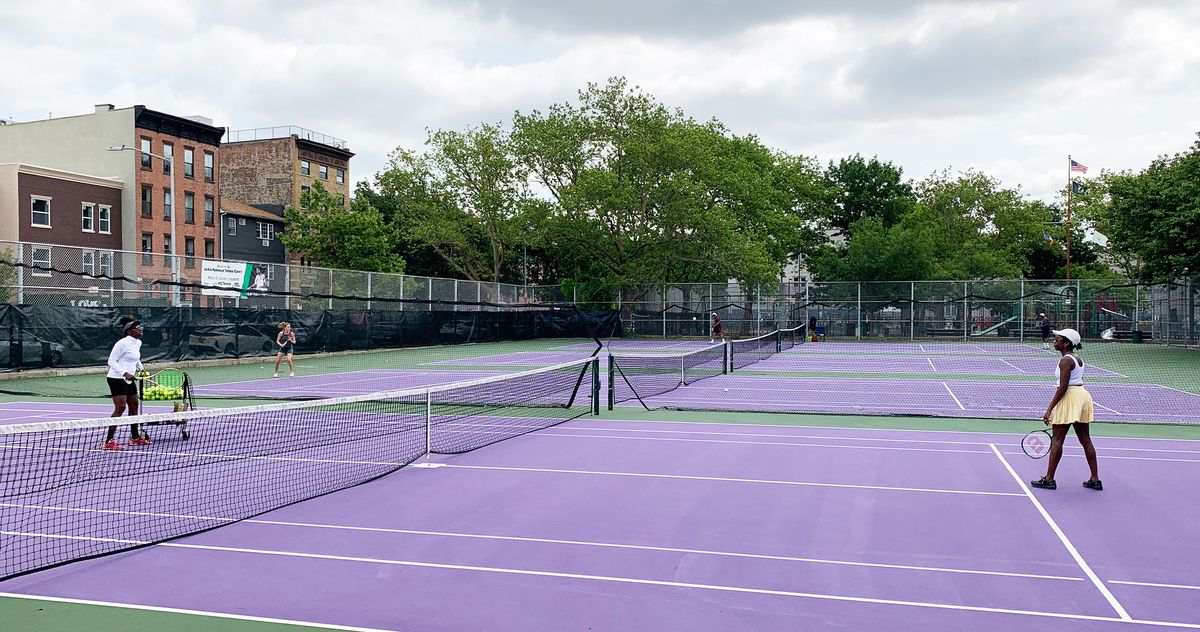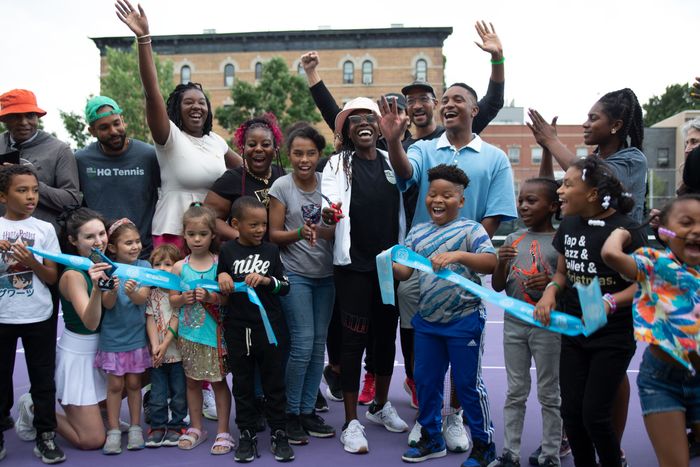Tennis
The Battle Over the Bed-Stuy Tennis Courts

Anyone who played tennis at Jackie Robinson knew Frances Ferdinand. A young Black mother with a quick smile, she offered free tennis classes every Friday in the summer at the Bed-Stuy courts, and has the kind of energy that can hold the attention of easily distracted kids learning to hit the ball over the net. She would play music and crack jokes with the adults, let teens borrow rackets after school, and lead community cleanups at the surrounding park and playground. “Nobody cared about these courts,” says Ferdinand, who grew up playing tennis at Jackie Robinson and other courts in the borough. “We were mending them ourselves.” She held the contract to teach there for the last five years, and kept pushing the city to resurface the courts, which had been busted-up for decades. When that finally happened, as part of a 2023 upgrade to the park’s storm drains, the fresh hardtop was painted a vibrant purple at her request. The new courts, now silky smooth, seemed to come alive after the renovation. Suddenly it seemed all of Brooklyn wanted to play on Malcolm X Boulevard. And just as quickly, Ferdinand was out of a job.
“It had been one of the easiest places in the city to get a court,” says Brandon Wilner, a tennis player who lives nearby. “But since the courts opened up, you see a lot more of the Fort Greene crowd and people taking the A over.” (By 4:30pm on a recent Tuesday afternoon the courts were already full.) Increased player interest also meant increased interest in this year’s blind bidding process, which grants an individual or a business the exclusive right to run lessons on one of the park’s four courts. In 2019, Ferdinand was the only person to bid at Jackie Robinson with an offer of $6,700 for the five-year contract. This year, the contract was up again and another tennis instructor who lives in Bed-Stuy and teaches at the McCarren Tennis Center, Omar Durrani, handily outspent her — $40,000 to her $9,000. City rules require the Parks Department to go with the highest bid when granting concessions, which the department says is a way to ensure the process is fair, and Durrani got it. Ferdinand still says she felt blindsided, believing her work in the community should have been taken into account while considering bids.
Durrani had also won the contracts at Lincoln Terrace and Astoria Park, and set up a website announcing his new venture: Love All Tennis. His business is a slightly more scaled up version of what Ferdinand was doing with her company, HQ Tennis — he charges a yearly membership of $60, which allows adults to book lessons at any of the three parks for a $65 group lesson or a $111 private lesson with himself or three other coaches he’s hired. But unlike Ferdinand, who offered free lessons in the summer, hosted local tournaments, and fundraised tennis scholarships to make the sport more accessible to the community, Durrani’s venture, at least thus far, seems to strictly be a business one. (Durrani declined to comment for this story.)
City contracts like this change hands all the time, but Durrani’s early days on the court were tense: “He basically came and shut down our practice,” Jonah Candelario, a coach who works for Ferdinand, said of a kids clinic he was running after the new contract had been announced. (The Parks Department says paid tennis lessons on the courts without a permit is not allowed.) Durrani started taking down Ferdinand’s signs and texted her to remove a supply shed she kept near the courts. Ralph James, a long-time Bed-Stuy resident who helps Ferdinand open up the courts, said that he got into a heated argument with Durrani about it. “I lost it,” James said. “You just come to a neighborhood and start tearing down stuff.” Durrani ended up calling the police on him. A week or so later, James was also there when a group of women started to do a tennis workout lesson on the courts. The women say that Durrani, who was running a lesson on the court he’s contracted for, ran over to them and told them to move. “He was telling us we’re taking his customers,” said Ife Obi, who owns a local wellness studio nearby called The Fit In that partners with Ferdinand. James intervened, telling Durrani to walk away. Things between them got heated again and Durrani called the cops on him, again.
Court regulars were not happy. “We already have a problem with gentrification,” says Reneé Sheffey, a local pastor who works with Ferdinand through a group called the Friends of Jackie Robinson Park. “People are sensitive about it, rightfully so.” Ferdinand began a petition to appeal the city’s decision, calling Durrani a bidder with “deep pockets” without ties to the neighborhood. Chi Ossé, the city council member for Bed-Stuy, made a video on the courts to support Ferdinand. Ferdinand’s students turned out. A flier advertising a rally organized by a community member on the Jackie Robinson courts in June reads: “No Highest Bidder.” “I think when some of these rules were created, they weren’t taking into account gentrification and our shifting communities,” Ossé said. He argued that the city should take another look at the concessions system to prioritize community engagement.
HQ Tennis celebrates the newly resurfaced tennis courts at Jackie Robinson Park during a ribbon-cutting ceremony alongside New York City Councilman Chi Ossé.
Photo: Jonah Candelario
Tennis is an outlier sport in the New York City park system. If you want to play basketball, you show up with a ball. If you want to play handball, you show up with a ball. If you want to play tennis, though, players have to pay $100 for an annual permit. This has long made it a sport that feels out of reach for a lot of people. (A 2019 analysis from The Wall Street Journal found that even after the Parks Department had lowered the fee from $200, more than a third of all permit holders lived in the Upper West Side and Upper East Side.) Many courts in the city are also run through public-private partnerships that can come with their own fee systems. In McCarren Park, for example, the courts are roofed over in the off-season by the McCarren Tennis Center, a private company that charges a fee to play, a percentage of which goes to the city.
Part of the issue is that tennis is a space-intensive sport where demand is high, a problem that has only grown as more people started playing during COVID. “Playing in the city is a huge pain in the ass,” Wilner said. “People are fighting over a small, finite amount of resources — it almost makes me wish I played pickleball.” And like the rest of the city park ecosystem, the quality of the courts can vary widely, often depending on whether there’s a local tennis association to take care of them (the Parks department certainly doesn’t have the budget to keep them pristine). This also affects who comes and how competitive it gets for court time. At Fort Greene Park, which has a full-time Parks attendant and an associated non-profit, sign up sheets are put out at 7:30am every morning and are usually full within the hour. But at Jackie Robinson, even with the new crowds, the mood is much less cutthroat and it’s known as a place where people rarely check player permits and those who come to play figure out a schedule among themselves. Ferdinand, according to her fans, had run a different kind of court: “I just think she was really instrumental in getting the neighborhood interested in tennis,” says Kiel Cariah, a coach who used to work for Ferdinand. She attracted the kind of players who might not have otherwise turned up, he said, “because it’s a quote-unquote rich sport.”
But tennis can feel like a rich person’s sport for a reason. Playing at nice courts often means paying a fee, in part because maintaining a court can be expensive, and for the most part, it’s private operators who have that kind of cash: Michael DiRaimondo, the owner of the McCarren Tennis Center, said that he’s paid for the public courts to be resurfaced twice since 2017 and installed $100,000 worth of lights so people can play at night. “There were complaints the first year because the bubble went up when the weather was pretty decent,” DiRaimondo said. “But once people saw it was seven days a week, 18 hours a day of service, we had tremendous fans.” Meanwhile, even the money raised by concessions and permits doesn’t go directly back to the Parks Department, which is severely underfunded, but rather the city’s general fund. All of this can lead to a tension between accessible tennis and good tennis, and what Ferdinand was offering in the mostly elite sport was rare enough that her loss seems to have hit a nerve.
The courts at Jackie Robinson look different now, with new coaches and new crowds. During a recent visit, a number of people told me they were upset about the concessions changing over, while a few had no idea at all. It’s been an awkward adjustment, but after a few weeks, Durrani himself seems to have taken a step back, showing up at the courts less. Regulars say that there haven’t been any issues with the coaches Durrani has hired, who seem to want no part of the drama. “He has the legal right to teach there but the whole situation just sucks,” Candelario said. Local players are fundraising to keep Ferdinand’s tennis non-profit going, but Ferdinand is technically out of court one. (Some aren’t having it — James said he’ll change the locks every day if he has to.) Ferdinand still gives lessons on the courts when they’re open, but sometimes moves kids to the handball court to avoid any issues. “Everybody I had seen growing up were Black people playing on the courts,” she tells me. ”Now all of a sudden people are coming in telling you what you have access to.”











